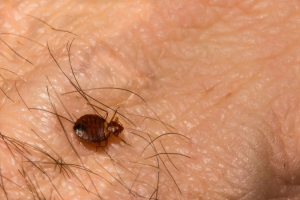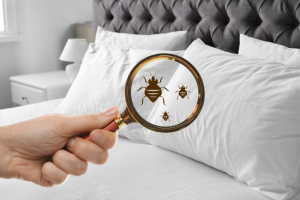BITTEN by the BUG

Bed bugs have become a global nightmare. From infestations across public spaces in Paris to causing panic over potential outbreaks in Europe and the US to terrifying Asia, including South Korea and Hong Kong, these pests are fueling fresh anxieties among the public and giving a significant business boom to pest exterminators. Even Singapore was not spared by this panic bug. Major pest control firms in Singapore have reported an increase in infestation numbers here and are predicting that there will be more to come, as international travel volumes increase and travellers unintentionally bring these critters to Singapore from overseas.
The fact is: bed bugs have been unwelcome companions to humans for centuries, with documented cases dating back to ancient civilisations. These resilient creatures have adapted to changes in living conditions and pest control methods throughout history. While the latter half of the 20th century briefly witnessed a decline in bed bug infestations due to the widespread use of potent insecticides like DDT (dichlorodiphenyltrichloroethane), bans on such chemicals and increased global travel have contributed to the resurgence of these blood-feeding pests. In this article, we take a comprehensive look at the biology, behaviour, detection, prevention, as well as treatment and control against these pesky pests.

BIOLOGY AND BEHAVIOUR
Would you recognise a bed bug if you saw one? For the uninitiated, bed bugs are small, flattened insects with an oval-shaped body. Adult bed bugs typically measure 4-5mm in length, making them difficult to spot. They have six legs and antennae, but lack wings, rendering them unable to fly. They are usually brown, but when filled with blood, can appear red or a darker shade of brown. Nymphs are smaller and lighter in colour. Due to their colour, these tiny pests can easily blend into various surfaces, further complicating their detection.
Understanding the life cycle of bed bugs is crucial for effective pest control. Bed bugs undergo simple metamorphosis, consisting of egg, nymph and adult stages. Female bed bugs can lay hundreds of eggs during their lifetime, which usually hatch within 6-10 days. These eggs are white and each is about the size of a pinhead. They are laid in clusters in small, tight spaces. The newly hatched nymphs go through five instars, molting and growing larger between each stage, before reaching adulthood. The entire life cycle, from egg to adult, typically takes about 5-8 weeks under favourable conditions.
Bed bugs are primarily nocturnal, preferring to feed on their hosts while they sleep. This behaviour is not only a survival strategy, but also contributes to the challenges of detecting and eliminating infestations. The bugs are attracted to the warmth and carbon dioxide emitted by their hosts, facilitating their feeding process.

FEEDING PROCESS
A bed bug’s feeding process involves the insect piercing the skin with its elongated mouthparts, known as a proboscis, to access blood vessels. It then injects saliva containing anticoagulants during feeding, preventing the host’s blood from clotting and ensuring a continuous flow. While the bites are usually painless due to the anaesthesia in their saliva, they often result in itchy welts, similar to mosquito bites, and allergic reactions in some individuals.
DETECTION
Detecting bed bug infestations can be challenging as these pests are skilled at hiding in cracks, crevices and other inconspicuous locations. Common signs include the presence of small reddish-brown bugs, molted exoskeletons, eggs, and/or tiny, dark fecal spots on bedding, mattresses, bed springs, furniture and walls. Additionally, the characteristic sweet, musty odour emitted by bed bugs can serve as an indicator of infestation.

FACTORS CONTRIBUTING TO INFESTATIONS
The resurgence in global travel has played a significant part in the increase of bed bug infestations around the world in recent times. Bed bugs can easily hitch a ride on luggage, clothing and other personal belongings, infesting new locations where these items are introduced. The lack of public awareness may have also contributed to the rapid spread of infestations in this respect, with people not aware of the potential signs of infestations as well as the preventive measures they can take. This inadvertently exacerbates the problem.
Another key reason for the increasing infestations is the bed bug’s growing resistance to insecticides. As mentioned earlier, the original method for treating bed bugs that emerged in the 1940s was the infamous DDT. Research eventually revealed DDT to have devastating environmental and health effects, and it was officially banned in the US in 1972 and worldwide at the Stockholm Convention in 2001, with the ban of many similar chemical pesticides to follow.
In addition to the negative environment and health effects, these traditional pesticides have caused resistance in bed bugs over time. Scientists conducted research and identified 14 genes collected from the bugs’ DNA which had altered and developed resistance. They found that successive generations of bed bugs have undergone genetic alteration, primarily in the epidermis of their exoskeleton. It seems that regular exposure to chemical pesticides has altered this key area of their body for protection, strengthening their exoskeleton to act as armour against pesticides.
Other factors which may contribute to increasing infestations include overcrowded or cluttered buildings and living conditions in urban environments, and increasingly warm weather around the world as bed bugs favour warm and humid temperatures, which is why they often thrive in the spring and summer seasons.

PREVENTION STRATEGIES
Here are some of the things you can do to prevent bed bug infestations in your home:
TRAVEL VIGILANCE
When travelling, put your suitcase on a luggage rack. Avoid storing your clothes in a drawer and try to inspect the hotel room with a torchlight. If you find bed bugs in your items, put them in a sealed zip-lock bag. And when you return from travel, inspect your luggage on a hard surface first – at the bathroom or near the entrance.
DECLUTTER
Reduce clutter in your home to reduce hiding places for bed bugs. Keep your house tidy and eliminate unnecessary items to reduce hiding spots.

CLEAN
Vacuum frequently to remove any bed bugs. Wash and dry your bedding, curtains, and clothing at high temperatures (at least 60° C). This kills both bugs and their eggs.
PROTECT
Use a light colour protective cover to encase your mattress to eliminate many hiding spots. The light colour of the encasement makes bed bugs easier to see. Be sure to purchase a high-quality encasement that will resist tearing and check the encasement regularly for holes, or you may also get a cover that has been pre-treated with pesticide to control bed bugs.
ISOLATE
Install door sweeps on the bottom of doors to discourage movement into hallways. Seal cracks and crevices around baseboards, light sockets, etc., to discourage movement through wall voids. Use caulk to seal these openings, preventing entry. Loose wallpaper also provides an ideal hiding spot for bed bugs, so ensure that your wallpaper and stick-on tiles are securely attached. Finally, inspect your rattan furniture. Rattan furniture is full of crevices and tight spaces which provide ideal hiding spots for bed bugs.

INSPECT
Early detection is crucial for effective bed bug control. Regularly inspect your sleeping areas, luggage and furniture is very crucial to follow instructions carefully. Overuse or misuse can be harmful. If you are unsure about using such remedies, do not attempt this on your own. If you wish to try it out, do ensure that pets and children are kept away from treated areas.
Finally, if these DIY treatment and control methods fail, seek help from professional pest control. Such services are often necessary for severe infestations. Exterminators employ a combination of chemical treatments, heat and other methods to eliminate bed bugs at all life stages.
PERSISTENT AND EVOLVING CHALLENGE
Bed bugs pose a persistent and evolving challenge to individuals and communities worldwide. Their resurgence in recent times underscores the importance of continued research, public awareness and integrated pest management strategies (prevention, treatment and control) to combat these pests. Addressing the multifaceted aspects of bed bug infestations – from biology and behaviour to prevention and treatment – is essential for effectively managing and minimising the impact of bed bugs in our homes.
@PRIME










